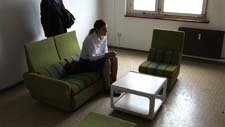Dora Garcia
dal 19/4/2007 al 30/6/2007
Segnalato da
19/4/2007
Dora Garcia
Museum of Contemporary Art, Leipzig
Rooms, conversations. Garcia uses the exhibition space as a platform to investigate the relationship between the visitor, the artwork and place. To this end the artist often draws on interactivity and performance. Through minimal changes, not encroaching on the space, the room is converted into a sensory experience, with each visitor leaving it again with his or her perceptions altered, or at the very least perhaps with a degree of skepticism. Curated by Julia Schaefer.

Rooms, conversations
Curated by Julia Schaefer
Dora García uses the exhibition space as a platform to investigate the relationship between the visitor, the artwork and place. To this end the artist often draws on interactivity and performance. Through minimal changes, not encroaching on the space, the room is converted into a sensory experience, with each visitor leaving it again with his or her perceptions altered, or at the very least perhaps with a degree of skepticism. By engaging with Dora García’s work we develop a sense to begin reading even the smallest signs as possible signifiers. The artist engages herself with the question of what is real and what is fiction. And thus visitors become protagonists in a fiction: sometimes knowingly, sometimes not.
While searching for information on the city of Leipzig during her Blinky Palermo grant from the East German Savings Bank- (Sparkasse-) Foundation together with the Leipzig Sparkasse, Dora García came across the Museum an der “Runden Ecke”, the Stasi and the events in Leipzig in 1989 (“The Peaceful Revolution”). Her work exhibited in the GfZK grapples with the history of the Stasi and engages itself with methods of surveillance.
It’s not a REENACTMENT; the plot plays out in an undetermined time and space.
Rather, Garcia focuses on abstract notions such as fear, control, authority,
dependency, absurdity and power, issues she also examined in previous works such as
“Fahrenheit 451 (1969)” (2003) or “Instant Narrative” (2007), which will be also
exhibited in the Leipzig show. Alongside her own videos, objects and installations,
Garcia has edited a selection of found footage, historical surveillance videos and
photographs
made by IM (unofficial collaborators with the Stasi). The material – here presented
out of its historical context – reveals itself surprisingly, as a peculiar form of
narrative: conceptually highly interesting examinations of human behaviour and
gestures that at times call to mind the Theatre of the Absurd.
Through the eyes of Spanish artist Dora Garcia, “Rooms, Conversations” opens a new
view onto a highly important and topical political and social issue. Garcia’s work
puts visitors into the unclear position of mentally or physically not always knowing
whether they are the actor or the spectator – whether or not they are playing a
role.
Curriculum Vitae
Dora Garcia (Valladolid, 1965) studied Fine Arts at the University of
Salamanca, Spain, and the Rijksakademie in Amsterdam, Holland. She lives and works
in Brussels. Since 1999 she has created several works on the web (doragarcia.net).
She has exhibited at the Manifesta 1998, Luxembourg, and the Istanbul Biennial 2003,
at the SMBA in Amsterdam (1997), the MACBA in Barcelona (2003), and the FRAC
Lorraine in Metz (2004). In 2007 she will participate in Munster Sculpture Projects.
Museum of Contemporary Art
Karl-Tauchnitz-Strasse, 9 - Leipzig
Tuesday through Sunday: 12 noon – 7pm



